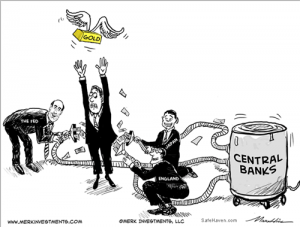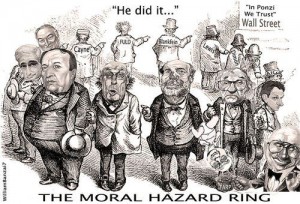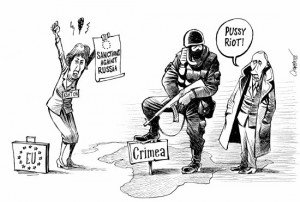The Consequences:
Quantitative easing is the only tool left available, with fiscal policies seriously constrained as result of the zero interest rates policy, and only applied because of the need to devaluing their currencies to repay their debts cheaply by reducing the ‘original value’ of the debt.
The logic behind zero and negative interest rates is foolish. The ECB’s thinking is – rather than lose money by placing it on deposit with them, they believe banks will lend it out for even just a marginal return, but there are obvious flaws in this strategy. The biggest is that the central bank is essentially forcing banks to lend out money they never would have lent in the first place. The easiest way to comprehend present-day monetary policy is to see it as a coordinated centrally planned effort  to suspend the consequences of the inevitable, resulting from the created economic folly.
to suspend the consequences of the inevitable, resulting from the created economic folly.
Another unintended consequence is the impact on savers. The Zero-interest-rate policy caused € 400 billion per year wealth transfer from savers to large banks. As a normalized interest-rate environment of at least 2% would pay € 400 billion to savers who leave money in the bank. Instead those savers get nothing, as the benefit goes to the banks that can relend the free money on a leveraged basis – through fractional reserve – and make big profits. Part of the Central Bankers design is to penalize savers and discourage them to leaving money in the bank, and encourage them to invest in risky assets, such as stocks and real estate, to prop up collateral values in those markets.
However many savers are inherently conservative and for good reason. Elderly, and retirees do not want to invest in stocks because they could lose easily a 30% of their retirement savings when the next bubble bursts. And younger people saving for a house down payment may avoid stocks for the same reason. Both type of savers hope to get a reasonable return on their bank accounts, but the Central Banks rate policy is that they receive nothing. As a result, many citizens are saving even more from retirement and pay checks to make up for the lack of a market interest rate. So the Central Bankers manipulations designed to discourage savings actually increase savings, on a precautionary basis, to make up for lost interest. This is a behavioural response apparently not taught in textbook economics or included in models used by Central Bankers.
Now this happens, depositors are pulling their money out of the banking system altogether — the exact opposite of the intended effect. The banking system would freeze up and deflation would spiral out of control as people are shoving their money under their mattresses. Causing a destructive counter productive effect.
Lending to small and medium size businesses (SME) is also damaged by this policy. But Central Banks don’t care as it favours the interest of big business and banks. Generally SME lending’s are funded through interbank lending, but such lending is unattractive today because of the zero rate interest, in other words banks cannot earn any money on those loans, as result of Central Bank intervention in this market. So, liquidity in interbank lending is low, as banks can no longer be confident that they can obtain funds when needed, why they don’t participate.
This credit crunch for SMEs is one reason unemployment stay persistently high. Big businesses don’t need banks to fund growth; they have sufficient internal cash resources for the funding of new activities and otherwise go to the bond market. However big businesses don’t create new jobs; job creation comes largely from small businesses. So when central banks distort the interbank lending market by keeping rates too low, it deprives small businesses of working capital loans and hurts their ability to fund for job creation.
Governments keep thinking the answer to economic growth and ultimately job creation is more innovation, so billions are invested in it. But an innovation is worthless unless an entrepreneur creates a business model for it and turns that innovative idea in something customers will buy. As ‘cause and effect’ of economic growth is misdiagnosed, so is the job creation misidentified.
For the first time in 35 years, American business deaths outnumber business births. Let’s get one thing clear: This economy is never truly coming back unless the birth and death trends are reversed for SME businesses. It is catastrophic to be dead wrong on the biggest issue of the last 50 years – the issue is where jobs come from – when ‘Small and Medium-Sized’ businesses are dying faster than they’re being born, so is free enterprise. And when free enterprise dies, the economy dies with it.
![]() Other unintended consequences of the Central Banks’ ZIRP policy are more opaque and sinister. One such consequence is the dangerous behaviour of banks in search of yield. With interest rates near zero, financial institutions have a difficult time making sufficient returns on equity, so they resort to leverage – the use of debt or derivatives, to increase their returns. Leverage from debt multiplies a bank’s balance sheet and simultaneously increases its capital requirements. Consequently financial institutions prefer derivative strategies using swaps and options to achieve the targeted returns, since derivatives are recorded off-balance-sheet and do not require as much capital as borrowing does.
Other unintended consequences of the Central Banks’ ZIRP policy are more opaque and sinister. One such consequence is the dangerous behaviour of banks in search of yield. With interest rates near zero, financial institutions have a difficult time making sufficient returns on equity, so they resort to leverage – the use of debt or derivatives, to increase their returns. Leverage from debt multiplies a bank’s balance sheet and simultaneously increases its capital requirements. Consequently financial institutions prefer derivative strategies using swaps and options to achieve the targeted returns, since derivatives are recorded off-balance-sheet and do not require as much capital as borrowing does.
Asset Swaps
Counterparties to derivative trades require high-quality collateral such a Treasures Notes to guarantee contractual performance. Often the quality of assets available for these banks’ collateral pledges is poor. In these circumstan ces, the bank that wants to do off -balance-sheet business will engage in ‘assets swaps’ with an institutional investor, whereby the bank gives the investor low-rated securities generating higher interest income, in exchange for higher rated securities such as Treasury notes. The bank promises to reverse the transaction at a later date so the institutional investor can get its Treasury notes back. Once the bank has the Treasury notes, it can pledge these to the derivatives counterpart as ‘good collateral’ and enter into the trade, thus earning high returns off-balance-sheet with scant capital required. As a result of the asset swap, a two party trade is turned into a three party trade, with more promises involved, and more complex web of reciprocal obligations involving banks and non-bank investors.
ces, the bank that wants to do off -balance-sheet business will engage in ‘assets swaps’ with an institutional investor, whereby the bank gives the investor low-rated securities generating higher interest income, in exchange for higher rated securities such as Treasury notes. The bank promises to reverse the transaction at a later date so the institutional investor can get its Treasury notes back. Once the bank has the Treasury notes, it can pledge these to the derivatives counterpart as ‘good collateral’ and enter into the trade, thus earning high returns off-balance-sheet with scant capital required. As a result of the asset swap, a two party trade is turned into a three party trade, with more promises involved, and more complex web of reciprocal obligations involving banks and non-bank investors.
These manoeuvres work as long as markets stay calm and there is no panic to repossess collateral. But in a liquidity crisis as experienced in 2008, these densely constructed webs of interlocking obligations quickly freeze up as the demand for ‘good’ collateral instantaneously exceeds the supply and parties scramble to dump all the collateral at fire-sale prices to raise cash. As a result of the scramble to seize ‘good’ collateral, another liquidity-driven panic soon begins, producing heavy tremors in the market.
Systematic Risk
 Asset swaps are just one of many ways financial institutions increase risk in the search for higher yields in low-interest-rate environments. A study by the IMF showed that the longer rates are held low, the greater the amount of risk taking by banks. The study concludes that extended periods of exceptionally low interest rates of the kind central banks have engineered since 2008 are a recipe for increased systematic risk. By manipulating interest rates to zero the CBs have encouraged the search for yields and all the off-balance-sheet tricks and asset swaps that go with it. In the course of putting out the fire from the last panic, the Fed has put supplied firewood for an even greater fire!
Asset swaps are just one of many ways financial institutions increase risk in the search for higher yields in low-interest-rate environments. A study by the IMF showed that the longer rates are held low, the greater the amount of risk taking by banks. The study concludes that extended periods of exceptionally low interest rates of the kind central banks have engineered since 2008 are a recipe for increased systematic risk. By manipulating interest rates to zero the CBs have encouraged the search for yields and all the off-balance-sheet tricks and asset swaps that go with it. In the course of putting out the fire from the last panic, the Fed has put supplied firewood for an even greater fire!
To hide the true financial condition banks use other off-balance-sheet accounting tricks too. Bloomberg reported last year a hardly known technique applied by many banks in rebooking their assets from “available for sale (AFS)” to “held-to-maturity (HTM)”. – Banks ordinarily buy bonds and other securities with the purpose to generating a return on that money, the sound ones are called, “Available for Sale,” because the bank can sell these assets to pay their depositors back. But here’s the problem – many of these investments have either lost money, or they soon will do so, and cannot be sold, and should be booked as a loss. However banks don’t want to disclose those losses. Instead, they simply re-label those assets as HTM. But banks cannot hold for ever bonds with a maturity up to 30-years. It could be money they might need to repay their customers tomorrow, which makes the entire charade a fraud. Similarly the same trick is applied with the bank’s real estate portfolios in which the entrees are made at acquiring values and not booked at market value that today generally is about 50% lower.
As horrible example: “JP Morgan alone boosted its HTM mortgage bonds from less than $10 million to nearly $17 billion (1700x higher) in just one year.” This is a huge accounting mutation. Nearly every big bank is doing this too, and doing it deliberately. This is no accident. And there’s only one reason to do it – to hide their losses. In other words it’s becoming extremely difficult to have confidence in western banks’ financial health. They employ in their books every dirty trick they can come up with to overstate their capital ratios and understate their risk levels and losses. And… marginal insolvent central banks and broke governments back all this.
Question yourself, is it really worth keeping your savings in this corrupted system?
Remember all paper currencies are actually not money but commercial debt instruments, as debt cannot be money – it’s the opposite of money, and consequently a total deceit!
The Fed will do everything to prop up the dollar. Gold and Silver are the antithesis of every paper currency. Destroy these currencies, and the US; UK, EU, and Japan’s economies will collapse. Expect the cabal to fight to death, and probably may come out ahead? Since the crime cabal are the owners of the game, they don’t bother which side wins, – West or East – they win anyhow.
The sanctions on Russia wreck the EU and have little, effect on Russia. Russia is already moving, with China and the BRICS, outside the dollar payments mechanism. As the demand for dollars drops, eventually the dollar’s exchange value will drop too. Initially, Washington will be able to force its vassals to support the dollar, but sooner or later this will become impossible.
Everyone wants higher yields:
Let’s have from a different angel a look at the Magic of ZIRP and NIRP – by follow the lead of Internet companies. – Invent some revolutionary type of social media exchange nobody has ever heard of. Raise $1 billion by selling bonds to the public. You have no credit and no credibility? No worries. The companies that have done best lately are those with the worst credit, according to Bloomberg. These “balance sheet bombs” have benefited most from ZIRP, NIRP, as the chance of collapsing spreads.
“Everybody wants high yield. And nobody believes the Fed will allow debtors to fail.” It continues… ”That a new company with NO track record, NO real product, NO profits, NO sales, and NO business plan should have the very worst credit rating possible… and should therefore be an cinch to get plenty of credit.”
In other words, borrow at twice the going rate for IBM – let’s say 4%. With a real inflation rate of >3.91%, you’re getting money for essentially nothing. But you still have to make debt payments…
“So borrow $1 billion. You have to pay $40 million in annual interest. But you take the $1 billion and use it to buy your products (whatever they are). Your company shows sales of $1 billion. You bring about 40% of that to the bottom line… giving you debt cover of 10 times. This makes you one of the best credit risks on the market. Then, if your shares sell for 20 times earnings (modest for a tech company), the capital value of your company will soar by 20 x $400,000,000 = $8 billion!”
Started with nothing. “Through the magic of ZIRP and NIRP… along with some accounting chicanery… you now have a company worth $8 billion. Sound crazy? Yes. And that is almost exactly what the Fed is trying to encourage.”
Companies borrow. “They use the money to buy their shares. Stocks go up. This “wealth effect” is supposed to trickle down to the public, who are meant to buy the corporations’ products. Rising sales will produce higher profits. Stocks will go up. Everyone will be richer.”
The risk to the short-term investor may be that he misses out on this silly insanity. Asset prices go up; he wants to be a part of it. However the risk to the long-term investor arrives when the economy comes to its senses.
When unrest comes, there will be enough to worry about; at least you don’t want to worry about your savings. Only gold and silver will preserve value when things turn bad, why it is recommend that every saver have at least 5% of liquid assets in physical gold or silver, preferably stored outside the country of residence.
Eventually when things really turn bad, there will be no way shape or form that the mainstream media, Washington or Wall Street, can pretend that it is anything other than what has failed, is central bank policy.
Confirmation:
FT Headline: “Negative rates to rattle financial system. Impact to hit pension funds and insurance groups”.
FT is Cabal owned MSM that confirms this thesis.
War On Success: Here’s Why America Is Doomed – Mike Maloney
This is the war on success that governments are waging. They are trying to make the economy worse by putting companies out of business.
Keiser Report: Derp-like policy of ZIRP and NIRP

March 1, 2015 at 11:34 AM
MH17 Crash a False Flag – continued
Lies and deception: MH17 crashed eight-month ago and yet no word anymore about it, neither in the MSM nor from any Government source – the EU and the VS with the help of CIA and Mossad are reckless trying to create false flag operations with the aim others to blame, for which the public is mislead. All the evidence meanwhile points squarely in the direction of the western leaders. After 9/11 Twin Tower demolitions, Weapons of Mass Destructions which didn’t exist in Iraq, the world is awakening, most people don’t buy official statements any longer, causing scandalous deterioration of confidence. Elected leaders are too stupid to collaborate in deliberately killing innocent people they pretend to care for, on behalf of the secret agenda as drive for WW3. Altogether the conduct is an utter disdain for humanity and its wellbeing. https://finalwakeupcall.info/en/2014/09/11/mh17-crash-a-false-flag/
Reflections on MH17: The tragedy of MH17 in which 298 people lost their lives made the conflict in Ukraine real for many other countries. While the international community awaits the outcome of the crash investigation, speculation in the media continues to fuel the blame game. RTD travels far and wide to interview international experts on what has hindered the investigation, what procedures were needed to collect vital evidence and what might have brought down the ill-fated Boeing 777. http://rt.com/shows/documentary/223071-mh17-plane-crash-investigation/
March 2, 2015 at 6:56 PM
U.S. media is quick to blame Putin for the assassination of opposition leader Boris Nemtsov. – Russian Opposition: Putin Did NOT Assassinate Opposition Leader Boris Nemtsov. – Itina Khakamada a top ally of Nemtsov in the opposition said the killing was clearly not in Putins interest. Its aimed at rocking the situation. – Former Soviet leader Mikhail Gorbachev says the the killing is aimed at destabilising the situation in the country, at heightening confrontation with the West.
Gorbachev says: The assassination of Boris Nemtsov is an attempt to complicate the situation in the country, even to destabilize it by ratcheting up tensions between the government and the opposition.
Even the U.S. governments Voice of America states in an article entitled Could Nemtsov Threaten Putin in Death as in Life? that Putin loses much more than he gains by the assassination: